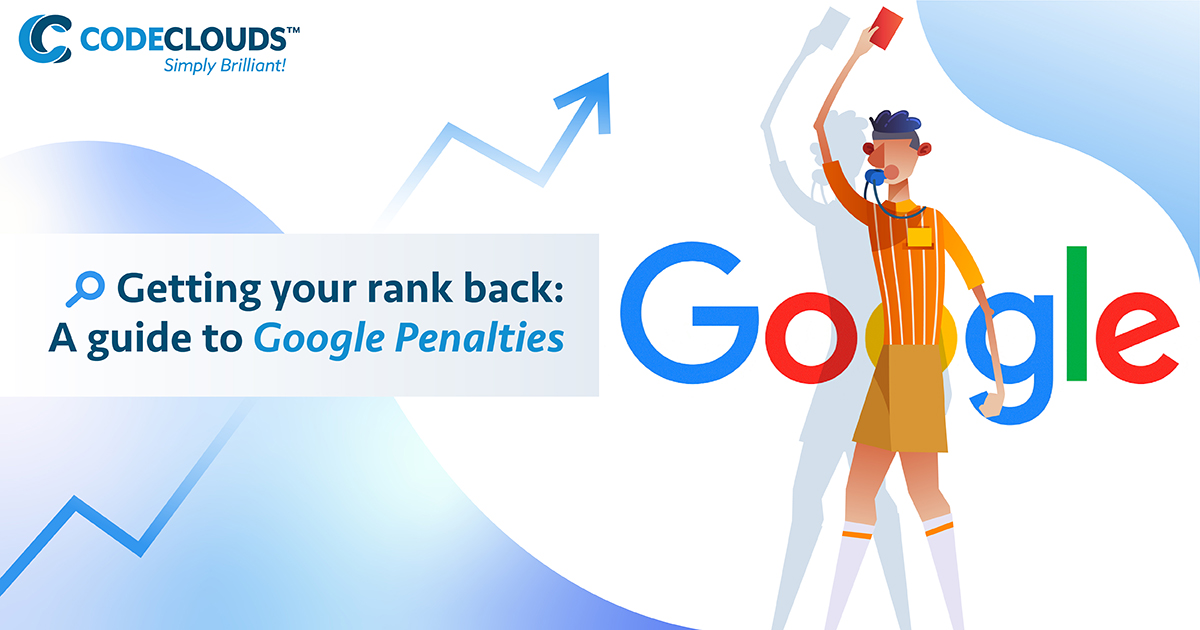Overview
It can be heartbreaking to see months of work undone and your page drop down through the SERPs because you got hit by a Google Penalty. Today we’re going to discuss what they are, and how you can bounce back.

It’s a nightmare scenario for any marketer. Yesterday your site was on the first SERP and now it’s on page 50 and you have no idea why—you changed nothing in your pages or your link strategy, but your ranking and inbound traffic have both fallen off a cliff. You’ve been hit by a Google penalty. Don’t worry: we’re here to help.
The first thing to do is figure out what sort of penalty you’ve been hit by. There are two main types of penalty: manual penalties and algorithmic penalties. Manual penalties have, as you’d expect, been manually applied by somebody at Google. An algorithmic penalty is based on one of Google’s automatic processes detecting something suspicious about your site profile. Penalty-causing or penalty-risking behaviour is sometimes called negative SEO, and that’s a good way to conceptualise it-if SEO helps you rise through search ranks, negative SEO is the force pulling you back down.
Common Causes of a Manual Penalty
Google has a huge team of reviewers whose whole job is to check whether sites conform to their quality guidelines. If they feel that you have failed to live up to them, they will hit you with a penalty that can be difficult to remove. Around 400,000 manual penalties go out each month. If you’re serious about understanding the issue I’d recommend reading the full guidelines yourself, however they are long so-for the sake of brevity— here’s the core things to be aware of:
- Unnatural Inbound Links are off-site links Google believes have been acquired as part of a link scheme. This is probably the most common manual penalty webmasters see. The flipside of this are unnatural outbound links: on-site links that seem to have been purchased by a third party for SEO purposes.
- All Flavours of Spam. Thin, duplicate, spun or otherwise low-quality content can get you a penalty, if Google thinks it has been created for the purpose of manipulating SEO. Merely bad writing won’t hurt you, but bad writing that is bad because the purpose of the content is not to be read but to get a search-engine bump will. Be aware that this includes user-submitted data like comments sections or forums—if you’re hosting it, it’s your problem.
- You’ve been hacked!Probably not by a man in a trenchcoat typing into a green CLI, but hacked nonetheless. If somebody has inserted malicious code into your site that spams users, creates illicit tracking cookies, or generally hijacks your site in order to get up to no good, Google will hit you hard. Once you’ve got this penalty, users of certain browsers and security suites might even be prevented from accessing your site at all until you fix the problem.
- There’s something wrong with your site. There’s a few different ways this can get you. If there’s something deceptive about your HTML (like misleading or keyword-stuffed metadata) then that’s a fairly easy fix. If there’s something wrong with your hosting then you’re probably going to need to migrate—free hosts are very popular with spammers, and sometimes you can get picked up by mistake because you share hosting with them.
If you’ve been hit by a manual penalty, the specifics of the issue will appear in your Google Search Console. Once you’ve solved that, you’re almost good to go. But, if you’re dealing with a different sort of penalty:
Zooming in on the Algorithms
This used to be very clear-cut with regularly announced releases, but it’s a bit muddier these days. The definition of negative SEO continues to expand, but in incrimental ways. Rather than releasing big block updates, Google now constantly modifies Penguin with a series of smaller rolling updates. The Moz keeps a running update tracker that I recommend, if you want to know what the latest changes are. The old updates still stick around though, and Penguin’s classic features are still a major source of algorithmic penalties.
- Google Panda Penalty. Every SEO marketer who was around in 2011 can tell you exactly where they were when Panda hit—despite the cute name, it was more of a grizzly bear. Overnight, Panda changed the SERP ranking of 12% of the entire internet. Panda is designed to target low-quality sites, and goes after thin and spammy content in the same way a manual spam reviewer would.Panda penalties apply to a whole section of the site, as well—if Panda picks up one blog post it deems to be low-quality, then it’ll hit the entire blog or even the entire site if it thinks the problem is bad enough. Panda’s last update was in 2015 and it’s not clear whether there are any more planned, but it is still very much in effect. Because Panda is no longer being updated, a Panda penalty will relate to new content you created, not changes in Google policy.
- Google Penguin Penalty. While Panda targeted content, Penguin targets bad links. I feel like we’re all on the same page at this point, but once more for the folks in the back: Google does not like link schemes. Penguin is constantly being updated, though the updates aren’t labelled ‘penguin’ any more—they’re given more generic names and rolled out without much fanfare. If something about your inbound or outbound links looks fishy, Penguin will snap that information up and you’ll take a rank hit until you can correct your behaviour. Some things Penguin takes into consideration are:
-
- Link Diversity: inbound links should be different, and Penguin likes them to come from 1) many different sites 2) a wide variety of types of source. That means if it’s all from comments sections it’s bad, if it’s all from the comments section of the same WordPress blog it’s very bad. If it’s 1000 comments on the same WordPress blog with the same anchor text and link, then kiss your ranking goodbye.
- Link Velocity: if you get all your inbound links posted at the same time and then there’s silence for six weeks, Penguin will get suspicious.
- Link Authority: if your inbound links are coming from sites that Google believes to be reliable, then Penguin is your friend. If they’re coming from sites it doesn’t trust, then you might be in trouble.
If you’re having trouble figuring out which change specifically has affected you, go back through your analytics and find the day when traffic dropped—if you compare it with the update release schedule and check the update documentation, it should be obvious what the issue is.
What can I do?
First, take steps to correct the issue. Google don’t look kindly on you if you come to them asking for a penalty to be removed but you haven’t done anything to stop the bad behaviour. Even if you’re not the one responsible, they like you to have reached out and tried to get things changed.
- To fix backlinks, the first thing to do is find them all. Google Analytics does this for free, but unfortunately has a lot of blind spots and rarely gives you a complete picture. It’s good to double-check with another tool like the SST Backlink Checker or Moz’s Link Explorer. Get in touch with the person running the site and ask them to take the link down. If that fails, use Google’s disavow tool, but be prepared to show Google proof that you tried to get them taken down first.
- Delete or edit spammy content. If you’ve got low-quality content with a lot of positive inbound links and traffic, edit it to be more helpful. If you don’t think there’s any point keeping it around, axe it: by doing nothing, it’s actively hurting you. Remember, this includes comments sections and other data you didn’t write yourself.
- Clean out any malicious or spammy code. Most hacks won’t actually take your site down or even be that obvious: they’ll be quiet scripts that you don’t see, that turns your site into part of a spam distribution network. Remain vigilant and do regular code maintenance.
- Make sure your on-site technical SEO is functioning properly. This one comes up more often than you’d think: a developer put a keywordy meta description on an image in 2010 and it’s been sitting there quietly unnoticed until a small Penguin change picks it up in 2019 and sends your rank crashing through the floor. Find a reliable host, get your SSL certificate sorted out, generally just clean the house and make sure everything is in order.
For manual penalties, the next step is going into the Google Search Console, Traffic → Manual Actions → Request a Review. From there, you can submit a formal request to get your penalty removed. As I mentioned, make sure you’ve done everything in your power to fix the problems first.
For algorithmic penalties, if you’ve correctly fixed the problem then the penalty should go away on its own. Give it a day or two and see whether you start to course-correct. If it’s not working, try something else. From personal experience, you tend to get it fairly quickly. Especially with the smaller, more precise updates we’ve had since 2015, it’s a lot easier to tell what you’ve done to anger the Great Penguin.
It gets a bit harder if the problem relates to something you did, or something that happened external to your website like a malicious backlink campaign. First, make a list of all content you launched up to 48 hours before the drop. Then, do a backlink audit and see if anything new has come up. Sometimes it’s an intentional malicious attack meant to tank your ranking, but often it’s just spam sites autogenerating backlinks. If a link looks suspicious, do not follow it—scammers will sometimes try to trap curious webmasters with spam links that lead to phishing sites.
Once you’ve identified any troublesome content or backlinks, go through the checklist we’ve covered above. It can be painstaking work, but these penalties can end sites, and need to be taken seriously. Your SEO campaign has been pushing you up, but negative SEO will drag you right back down.
Getting hit with a Google Penalty can ruin your day, and if you’re reading this article while desperately trying to get back on the first page of Google, I wish you the best of luck and I hope I’ve helped. You’re not alone here: BMW, the BBC and the Washington Post have all been hit by major penalties over the years, and they’re all still doing fine. May Penguin and Panda forever be on your side.

If you want to learn more about preventing future penalties, check out our article on SEO best practices. CodeClouds has design, development and eCommerce experts, and we’re happy to help you out with whatever project you need.
Share this article
284 reads








